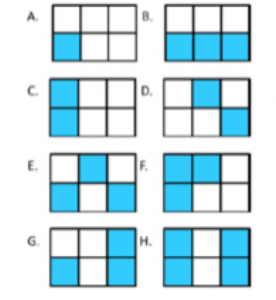| Grade Level | Task Prompt for ARP | Mathematical Focus | Mini Links |
| 3 | Who ate more of the candy bar?
Task: Olivia and Brett are eating candy bars. Olivia ate 1/3 of the candy bar and Brett ate ¼ of the candy bar. Brett said he ate the most. Olivia said she ate the most. Which student do you agree with and why? |
Definition of fractions Understanding how the denominator relates to the size of the parts. (partitioning) | Packet Overview |
| 4 | Is it ¼?
Task: What fraction of the rectangle below is shaded? Laura says that ¼ of the rectangle is shaded. |
Definition of fractions Fraction equivalency | Packet Overview |
| 5 | Comparing Fractions
Task: Javier claims that ½ is less than 3/8. Do you agree or disagree? |
Definition of fractions Comparing fractions with unlike denominators | Packet Overview |
| Multi-‐ grade (3–6) | Halves, Thirds & Sixths (from illustrativemath.org)
Task (3-5): What fraction of the area of the rectangle is shaded blue. Name the fraction in as many ways as you can. Explain your answers. Task (modified for 6): Find a fraction equivalent to 3/8. Use diagram, equations, and mathematical principles to prove the fractions are equivalent. |
Depending on grade Definitions of fractions. Equivalency of fractions: Explain why a fraction a/b is equivalent to a fraction (n × a)/(n × b) by using visual fraction models. Explaining equivalence … by reasoning about their size. | Packet Overview
Sorting Protocol |
| HSAlg I | DJ for the Prom
Task: In preparation for the Prom, students are researching the costs of two local DJ companies. Music Makers charges a fee of $200 and an additional $175 per hour. Dance Partners does not charge an initial fee, but charges $225 per hour. Which company would be more cost effective for the prom committee? Write a mathematical argument to support your decision. |
Depending on student approach: Understand the connection between proportional relationships and lines. Solve pairs of simultaneous linear equations. | Packet Overview |
| HSGeo | Which quadrilateral is it?
Task: The vertices of quadrilateral ABCD are A(-5,2), B(4,5), C(6, -1), D(-3,-4).Given the coordinates of the vertices of a quadrilateral, classify the quadrilateral as one of the following using the most specific classification possible: Parallelogram, Rectangle, Rhombus, Square, Trapezoid |
Definitions of quadrilaterals; relationships among quadrilaterals. Applications of Pythagorean theorem, distance formula, and/or slope formula. | Packet Overview |
Leap Frog Task – This task and work samples are from the MARS assessment site and Insidemathematics.org. The annotations on the work samples were generated by the Bridging Math Practices project team and reviewed by Bridging Math Practices participants.
| 4 | Leapfrog Fractions Task
Task description: Determine whether a frog that leaps three fractional distances from lily pad to lily pad and ultimately to an island will land on the Island (at 1). Copyright © 2009 by Mathematics Assessment Resource Service |
Mathematical Focus | The Task
Commentary on Student Work |
Protocols to guide work sample sorting activity
Protocol designed for ARPs (33-40 mins)
Protocol shortened (23-28 mins)
Protocol followed by full group discussion (40-55 mins). This is useful for larger group PD.
Some content on this website may require the use of a plug-in, such as Adobe Acrobat Viewer.
